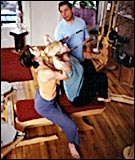
At first blush, red-sauce Italian restaurants may not seem all that simpatico with gyrotonics – a Pilates-like exercise in which people are strapped to complicated, old-fashioned devices that look, to the uninitiated, almost medieval. But Anthony Macagnone, the owner of New York’s Sal Anthony’s restaurant chain, couldn’t agree less.
“I turned a trattoria and a fish market into gyrotonic studios,” says Macagnone, who speaks with a tough-guy New York accent except when he hits Italian words, like mozzarella, and his voice turns singsong. “There is a common denominator between my restaurants and the movement salon, and that denominator is energy. Putting it in your mouth, or expending it. It’s the grail for living.” The chi, in other words, in the chianti. So, in the window of what used to be a tiny market on Irving Place, a video now shows a tall, bearded man pulling the arms and legs of a skinny girl who’s on, well, a rack.
Gyrotonics has been around for about 25 years. It was invented by Juliu Horvath (the bearded man), who ran a studio called White Cloud on the Upper West Side. But about five years ago, Macagnone decided the city at large could benefit from this strange, labor-intensive exercise that builds strength gently, through resistance. And Horvath now operates out of one of his converted restaurants, firming up Sal Anthony’s rep as the worldwide headquarters of the technique. “Let’s say you’re 20, you’re 40, you’re 60,” Macagnone says. “You can read and write, but you don’t understand kinesthetic literacy.” Gyrotonics, he explains, is not about bulking up but about becoming toned. “You build muscle, that’s armor. This is about anti-armoring the body. And that’s a kind of energy I understand.”